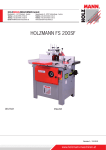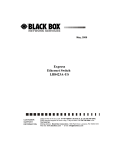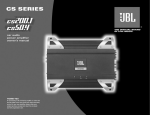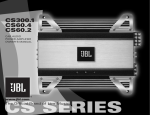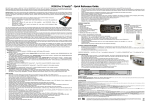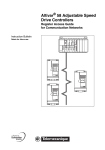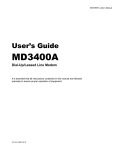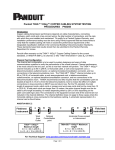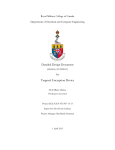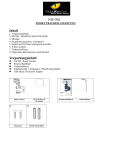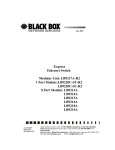Download Preface
Transcript
Preface This manual describes the installation and usage of the compact 8-port fast Ethernet switch with one fiber-optic port. This combination of fiber and TX ports in a compact box delivers the power of 100Mbps switching along with the distance of fiber. The compact size is ideal for using on the desk-top or mounting on the wall. The fiber port accommodates SC type connector. RJ-45 connects auto-negotiating 10/100BASE-TX transmission. In this manual, you will find: • Benefits of Ethernet switches • Features of this Ethernet Switch • LED functions illustration • Installation instructions • Networking examples • Specifications • Ethernet technology and LAN tutorial • Definitions of terms To get the most out of this manual, you should have an understanding of Ethernet networking concepts. Refer to the appendices and glossary definitions for expanded information. User’s Manual 1 Table of Contents PREFACE ....................................................................... 1 INTRODUCTION........................................................... 3 BENEFITS OF SWITCHING ............................................. 3 8-PORT ETHERNET SWITCH .......................................... 4 PRODUCT FEATURES .................................................... 5 PACKING LIST .............................................................. 5 FRONT PANEL .............................................................. 6 Uplink Port............................................................... 7 DIP Switch ............................................................... 7 INSTALLATION ............................................................ 9 SELECTING A SITE FOR THE SWITCH ............................ 9 CONNECTING TO POWER ............................................ 10 CONNECTING TO YOUR NETWORK ............................ 10 NETWORKING EXAMPLE ............................................ 11 SPECIFICATIONS ....................................................... 13 APPENDIX A - CONNECTOR PINOUTS.................. 15 APPENDIX B - INTRODUCTION TO LAN & ETHERNET TECHNOLOGIES ................................... 16 APPENDIX C - GLOSSARY ..................................... 19 2 User’s Manual Introduction Benefits of Switching Ethernet switching technology has dramatically boosted the total bandwidth of a network. It puts configuration flexibility and bandwidth adaptability into the local workgroups where the majority of work is generated. It further eliminates congestion problems inherent to the CSMA/CD protocol and improves predictable response time under heavy network loads. Expensive routing equipment was used in the past to reduce the congestion under heavy loads. The new wave of object-oriented client and server applications demands higher bandwidth and tighter integration of client workstations with servers. The old shared-access (hub/repeater) Ethernet technology provides neither enough bandwidth nor predictable response time for this new wave of workgroup computing. Fast Ethernet switching not only satisfies both technical and business requirements, but also preserves the user’s existing investment in the huge 10 Base-T Ethernet installed Base. This compatibility ensures a path for users to add, change, and migrate to Fast Ethernet as demands emerge. It also provides a low cost and flexible bandwidth solution directly to local workgroups where the majority of work is generated, reducing the need for expensive network equipment. User’s Manual 3 8-port Ethernet Switch This compact switch has seven RJ-45 ports and one fiber port. Each of the RJ-45 port is capable of auto-negotiate 10/100Mbps and full or half-duplex mode. The multimode fiber port is able to accommodate SC connector. The switch combines fiber and TX ports in a compact box, providing an inexpensive solution for interconnecting between buildings in a campus, multitenant location covering large areas or industrial environment. The fiber port provides the long distance capability and the space saving compact size makes it ideal for wall mounting or desktop. Store-and-forward, true non-blocking architecture and auto-negotiation are features of this switch to optimize performance and value of this switch. Installation and operation involves simply plugging in cabling and connecting power. This 8-port switch represents affordable, reliable, and easy-to-use LAN solutions. 4 User’s Manual Product Features List of features includes: • • • • • • • • • • • Fiber-optic connection for SC TX ports with auto-negotiation 10/100Mbps Auto-negotiation for speed and duplexity True non-blocking architecture Store-and-forward mechanism Back pressure and IEEE 802.3x compliant flow control Supports 1K MAC addresses One uplink port Rear DIP switch to force fiber transmission to half duplex Front panel port utilization and status LEDs Wall-mountable compact size Packing List When you unpack the switch, you should find the items listed below. Report any apparent damage or missing items immediately to your authorized reseller. • • • The 8-Port Switch User’s manual AC power cord User’s Manual 5 Front Panel The following pages explain the front LED functions. ¦ § ¨ © Figure 1: Front Panel ➀ Power: Indicates that there is power to the switch. ➁ 100/TX: Indicates the presence of 100Mbps when steady and flashes upon transmission (TX) 6 User’s Manual ➂ 10/RX: Indicates the presence of 10Mbps when steady and flashes when receiving (RX) data ➃ FDX/COL: Detects the presence of full-duplex (FDX) and flashes upon collision (COL) of traffic Uplink Port An uplink port allows connection, through the TX ports, to another regular (i.e. non-uplink) port of a switch or hub. The labeled uplink port on the switch is located adjacent to port 7TX. Port 7TX & uplink-port are mutually exclusive. If port 7TX is in use, the uplink-port will be automatically disabled and vise versa. If connecting to an uplink port of a hub or another switch, any of the regular ports can be used. To connect two regular RJ-45 ports between any two switches or hubs, you need a cross-wire cable. DIP Switch The DIP switch allows fixed settings. Locate the DIP switch in the back of the switch. Figure 2 summarizes these settings. Pin 1: changes the traffic of the fiber-optic port to halfduplex when moved up to the ON position; full-duplex in the OFF position. User’s Manual 7 Pin 2: enables fixed-setting of the TX Port 1 by moving up to the ON position; activates auto-negotiation in the OFF setting. Pin 2 must be in the ON position in order to change port settings with pins 3 and 4. Pin 3: forces 10Mbps speed on port 1 when in the ON position; forces 100Mbps speed on port 1 when in the OFF position. Note: new setting will not be activated unless fixed-setting is enabled. Pin 4: forces half-duplex on port 1 when in the ON position; full-duplex in the OFF position. Note: new setting will not be activated unless fixed-setting is enabled. Fiber Port Setting 1 Port 1 Settings 2 4 Enable Fixed Settings 10 Mbps Half duplex Full duplex Autonegotiation 100 Mbps Full duplex Table 1: DIP switch settings defined 8 3 Half duplex User’s Manual Installation Selecting a Site for the Switch As with any electronic device, do not subject the Ethernet switch to extreme temperatures, humidity, or electromagnetic interference. Specifically, the site you select should meet the following requirements: • • • • • Room temperature of between 0-40°C (32104°F) Relative humidity of less than 90 percent, non-condensing. Electromagnetic field (RFC) of surrounding devices not to exceed standards for IEC 801-3, Level 2 (3V/M) field strength. Adequate ventilation. Do not block the ventilation holes on the side of the switch or the fan exhaust port on the rear of the switch. Power outlet located within 1.8Meter of the switch. User’s Manual 9 Connecting to Power Connect the supplied AC power cord to the receptacle on the back of the switch, and then plug the cord into a standard AC outlet with a voltage range from 100 to 240 VAC. Turn on the switch by flipping the ON/OFF switch on the rear of the unit to the I (ON) position. The O position is OFF. Connecting to Your Network Consult Table 1 for specific cabling requirements. Prepare cable with connections corresponding to the port. Install the same type of connectors at both ends for proper performance. With the power switch in the OFF position, connect the cables. No further installation is necessary. Table 1: Cable Specifications Speed Connector Port Speed Half/Full Duplex Cable Range 100BASETX RJ-45 100/200 Mbps Category 5 UTP 100 meters 10BASE-T RJ-45 10/20 Mbps Category 3, 4, or 5 UTP 100 meters 100BASEFX SC 200 Mbps 62.5/125 micron fiberoptic cable 2 kilometers 10 User’s Manual Networking Example We Connect Classrooms Classroom A 7TX +1FX Switch 100Mbps Fiber (Up to 6,560 ft) 100Mbps Copper 12-port fiber Switch Classroom B 7TX +1FX Switch 10Mbps Copper 100Mbps Fiber (Up to 6,560 ft) 100Mbps Copper ADMINISTRATION BUILDING Figure 2: K-12 Networking for classrooms User’s Manual 11 TX to Classes TX to Classes TX to Classes Figure 3: Networking for multi-users 12 User’s Manual Specifications Applicable Standards 10BASE-T, IEEE 802.3 100BASE-TX, IEEE 802.3u 10BASE-TX: Performance 100BASE-TX: 10Mbps half-duplex 20Mbps full-duplex 100Mbps half-duplex 200Mbps full-duplex 100BASE-FX: 100Mbps half-duplex 200Mbps full-duplex Forwarding Rate 148,800pps for 100Mbps LEDs Power, 100TX, 10/RX, FDX/COL Switching Method Store-and-forward 14,880pps for 10Mbps User’s Manual 13 Dimensions Weight Power Input W254 X D135 X H35 mm W10 X D5.3 X 1.4 in. 1.6kg 3.5lb. 100-250VAC, 47-63Hz internal Universal Power Supply Power Consumption 11 W max. Operating Temperature 0-40°C 32-104°F Storage Temperature Humidity -25-70°C -13-158°F 10%-90% non-condensing Emissions FCC part 15 Class B, CE mark, VCCI Class B Safety UL rating 14 User’s Manual Appendix A - Connector Pinouts Pin arrangement of RJ-45 connectors Figure 4: RJ-45 Connector and Cable Pins The following table lists the pinout of 10/100BASE-T/TX ports Table 7: Connector Pin-Out Pin Regular Ports Uplink port 1 Input Receive Data + Output Transmit Data + 2 Input Receive Data Output Transmit Data 3 Output Transmit Data + Input Receive Data + 4 NC NC 5 NC NC 6 Output Transmit Data Input Receive Data 7 NC NC 8 NC NC User’s Manual 15 Appendix B - Introduction to LAN & Ethernet Technologies As communication and business applications become increasingly complex, computer networking has evolved as a very important part of the infrastructure. Communication systems like Local Area Network (LAN) evolved into sophisticated, powerful, yet flexible technology. Among the different types of LAN technologies, Ethernet represents the best in speed, cost, ease of installation, and supportability. LAN Local Area Network (LAN) technology gave personal computers the power to share resources of hardware and software. LAN connects personal computers, file servers, printers, etc. together within a geographical area, usually a single building. Multiple, widely dispersed LAN systems are referred to as a wide area network (WAN). Ethernet Technologies More than 80 percent of all LANs utilize Ethernet technology. The Institute of Electrical and Electronic Engineers (IEEE) standardized Ethernet in IEEE 802.3, which provides for configuration rules, interaction requirements, types of media, and data rate. 16 User’s Manual Fast Ethernet For networks that need higher transmission speeds, a faster speed was developed and IEEE next established IEEE 802.3u, raising the Ethernet speed from 10Mbps to 100Mbps. Thus, fast Ethernet arose and users quickly began converting from 10Mbps to 100Mbps. Gigabit Ethernet The demand for even higher speed created the gigabit Ethernet at 1000Mbps (or 1Gbps). The newer IEEE standard for gigabit Ethernet is IEEE 802.3z. The only cabling media approved is the fiber-optic pair. The IEEE has already begun discussions to standardize 10Gbps (“10Gig”) Ethernet. Ethernet Products Hub One of the earlier connection solutions for Ethernet, a hub (also called a repeater) operates by broadcasting data to all ports simultaneously, and repeating the process until the data is received by the intended node. The hub works through a “shared network” with all of the nodes in the network segment sharing the same collision domain. Switches and bridges emerged because of a need to separate collision domains that are too large, therefore improving performance and network reliability. User’s Manual 17 Switch A switch solves the collision problem by working as a single domain. A Switch maps the physical Ethernet addresses of the nodes residing on each network segment and then allows only the necessary traffic to pass through. Packets of data are transmitted along with the destination and source segment. There are two basic architectures of LAN switches, cutthrough and store-and-forward. Cut-through switches consider only the destination address before forwarding it on to its destination segment, but store-and-forward architecture accepts and then analyzes the entire packet before forwarding. This allows the switch to stop certain packet errors from propagating through the network. The store-and forward switch eliminates redundant or corrupted packets, thus increasing the efficiency of the network transmission. 18 User’s Manual Appendix C - Glossary Glossary 10BASE-T Networking standard for twisted-pair cabling capable of carrying data at 10Mbps; also called Twisted Pair Ethernet 100BASE-TX Networking standard for two pairs of high-quality twisted-pair wires carrying data at 100Mbps 10BASE-F Networking standard for fiber-optic cabling capable of carrying data at 10Mbps 100BASE-FX Networking standard for fiber-optic cabling capable of carrying data at 100Mbps adapter Expansion card that enables a computer (network) to attach to a network ASIC Application-specific integrated circuit; a chip designed for a particular application and built by connecting an existing arrangement of circuit building blocks in new ways; ASICs are commonly used in networking devices to maximize performance with minimum cost autoProcess by which a network device discovery automatically searches through a range of network addresses and discovers all known types of devices present in that range User’s Manual 19 autonegotiation backbone backplane bandwidth broadcast bus category 5 client/ server collapsed backbone collision 20 Two-part process by which a network device automatically senses the speed and duplex capability of another device Interconnection within a LAN or WAN between subnetworks or workgroups within an enterprise Bus or switching matrix that resides within a switch or hub chassis; all traffic through such a device crosses the backplane at least once Amount of data that can be transmitted in a fixed amount of time; usually expressed in bits or bytes per second message forwarded to all destinations on a network Connector or set of connectors that serve as the interconnection between related devices Networking standard certifying that a copper wire cable can carry data at up to 100Mbps Distributed computing model where desktop "clients" can access and share information resources from multiple "servers" LAN architecture in which the subnetwork interconnection is concentrated within a switching hub or router Concurrent Ethernet transmissions from two or more devices on the same segment User’s Manual concentrator CRC desktop switch EIFO Ethernet Fast Ethernet Fiber-optic cable firmware full-duplex Gigabit Ethernet half-duplex hub Device used in a LAN to combine transmissions from a cluster of nodes; often called a hub Cyclical redundancy check; a procedure used to check for errors in data transmission A switching hub designed to support a single MAC address, or client on each port Ethernet in, FDDI out Networking standard for transmitting data at 10Mbps Networking standard for transmitting data at 100Mbps Cable made of thin glass threads that carry data in the form of light pulses software routines that are permanently written onto read-only memory a communications technique that allows bi-directional, simultaneous transmission between two devices on a single 10Base-T segment networking standard for transmitting data at 1000Mbps a communications technique in which one device on a segment transmits while the other receives, then the process is reversed a device providing a common connection among computers in a startype network; all ports within a hub share the total bandwidth of the domain User’s Manual 21 IEEE 802 set of Institute of Electrical and Electronic Engineers standards for defining methods of access and control on LANs LAN local area network; a network where computers are connected in close proximity, such as in the same building or office park; a system of LANs connected at a distance is called a widearea network (WAN) MAC address media access control address; a hardware address that uniquely identifies each node of a network Mbps millions of bits per second OEM original equipment manufacturer; a manufacturer that typically purchases components from other manufacturers, integrates them into its own products, and sell the products to the public out-of-band transmission of control information outside the bandwidth frequencies that transfer a network's data port density number of ports, either physical or logical, per network device PORT advanced feature of switching hubs that MIRRORING allows one port's MAC layer data to be replicated to another port for monitoring by a network analyzer runt any frame that is shorter than the minimum valid size of 64 bytes; runt frames are usually caused by collisions or faulty network interface cards 22 User’s Manual store-andforward switch switch motherboard switching fabric UTP VLAN wire speed switching feature where the receiving port receives the entire incoming frame and stores it in the buffers before forwarding it to the destination port; unlike cut-through switching, this method checks for runts and error frames and forwards only the good packets to the destination device that filters and forwards packets between LAN segments main board inside a switch where the switching circuitry is located a term used to specify the maximum bandwidth of a switch at the backplane unshielded twisted pair; cabling with wires that are twisted around each other; the individual wires are uninstalled virtual LAN; a process that defines network segment membership through the use of software; VLANs allow the network administrator to resegement the network without physically rearranging the devices or network connections the ability to handle the fastest rate of traffic that a generator can deliver without dropping packets; on a 100Mbps connection, wire-speed traffic is 148,809 packets per second using 64 byte frames or 8,127 packets per second using 1,518 byte frames User’s Manual 23

























